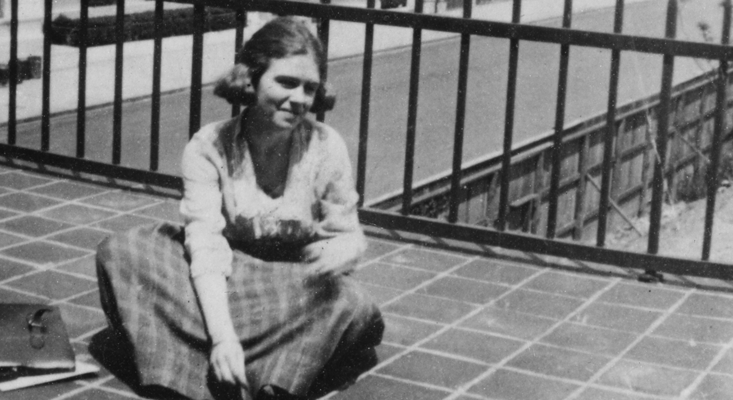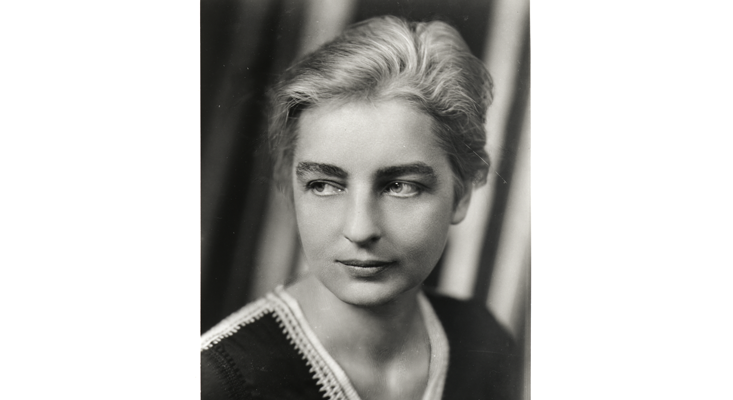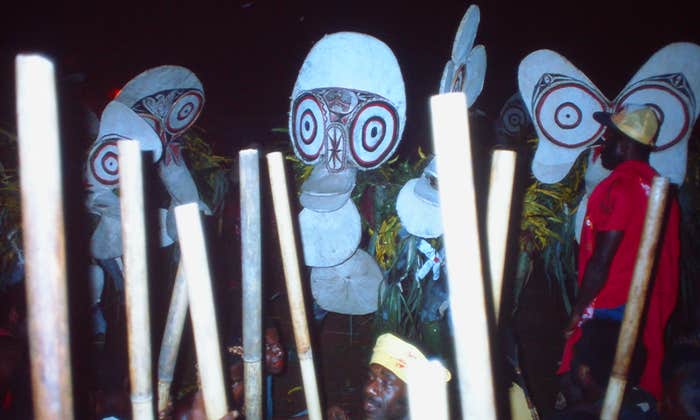In July 1925, Margaret Mead, a doctoral student at Columbia University, set off on a cross-country train journey with a young faculty member, Ruth Benedict. Mead was bound for the west coast and then American Samoa, her first fieldwork expedition as a junior anthropologist. Benedict was stopping in New Mexico to study myth and ritual in the Zuni Pueblo. The journey took them through Ohio to Illinois, across the prairie, then south toward the deserts. It was the longest the two of them had ever spent together, certainly the longest without their husbands in tow.
They had become acquainted more than two years earlier, Mead as an undergraduate at Barnard College, Benedict as her teaching assistant. It had taken time for Mead to stop referring to “Mrs. Benedict,” but over the years, something had changed. “She rests me like a padded chair and a fireplace,” Benedict jotted in her diary. Now, on the train west, Mead would remember weeping in Benedict’s arms, parsing her troubled marriage and other romantic entanglements. Benedict would later lie awake thinking of the nights they spent on the train—making love, kissing Mead’s fingers, trailing her lips across the palm of her hand. “Tofa, my sweetheart,” Mead wrote in a letter once she got to Samoa, using the local term for goodbye. “In my dreams I bury my face in your hair.” She had long signed her notes to Benedict with “love,” as one might to an older sister. But now she could say it all plainly, outright. “And always I love you.”
For the rest of their lives together, they would be each other’s polestar, sharing insights and triumphs, frustrations from the field, gossip from the Columbia anthropology department, confidences about their marriages to men and their romances with other women, and critiques of whatever manuscript the other one happened to be working on at the time. “For the first time in my life, I expect defeat,” Mead told Benedict not long after they parted near Gallup, New Mexico. But within a few years, she was on her way to becoming one of the most celebrated and controversial public scientists of the century. The book she completed after that trip, Coming of Age in Samoa, published in 1928, would be hailed as a classic in the literature on sexuality and adolescence. Benedict’s star was slower to rise but no less brilliant. Her Patterns of Culture, published in 1934, and The Chrysanthemum and the Sword, an empathetic analysis of Japanese society published right after World War II, remain signposts in the history of the social sciences.
For Mead and Benedict, social theory was a tool for making sense of the world, but it could also be a lever against your own predicaments. To do anthropology well, you had to alienate yourself from everything familiar, to take a slow train toward another way of seeing reality. The payoff was a liberating and original way of viewing your own society, denuded of its specialness and its constraints. And if you had always felt somehow out of kilter in your own culture—an “abnormal” or a “deviant,” an “invert” or a “mixed type,” as Benedict would later put it in her writings—you might come to understand why your own life had been such a struggle.

“I believe every person of ordinary sex endowment has a capacity for diffuse ‘homosexual’ sex expression,” Mead wrote to Benedict in 1933, this time from a new field site in New Guinea. “To call men who prefer [a] different expression ‘feminine’ or women … ‘masculine,’ or both ‘mixed types’ is a lot of obfuscation.” Everything was to some degree potentiality, until it got channeled in a specific direction by circumstance and the rule-scape into which one was born. Mead had seen all of this at work among people she met in the field—the “deviants” who lived perfectly satisfactory lives when a given society made room for them—and she could see it in herself, in the hidden yearnings and desires she shared with Benedict. She was now pursuing a new line of thought that would be “the climax of the work I’ve done this last year,” she told Benedict, “a combination of anthropology and reviewed biography.”
What if a key to understanding human difference lay in how societies standardized an individual’s specific personality? All this was easiest to see, Mead said, when it came to women and men. In her fieldwork in New Guinea and elsewhere, she had recorded men who dressed as women, women who took on the social role of men, and everything in between. But describing things that way felt like a conceptual straitjacket. She found herself forced to explain an entirely different social world by relying only on the binary categories of female and male that she knew from her own society.
How could Mead make sense of a way of being and loving that, in her own society, was cloaked in angst and secrecy?
The world Mead knew best—the United States in the interwar years—had selected a thing it called sex to be the container in which an individual’s essential self resided. Biological women and men were said to have basic qualities that everyone in the culture could describe fluently. Boldness, aggressiveness, and dominance got catalogued as male. Gentleness, motherliness, and creativity got catalogued as female. But no one in Mead’s society associated being big-eared or green-eyed with inherent traits of character. Claiming that people with protruding ears were naturally weak-willed, for example, would seem plain silly. Her culture had evolved in such a way that being female or male was a basic, binary, and deeply meaningful way of classifying reality. Having prominent ears or green eyes wasn’t.
By 1935 she had wrapped these thoughts into a new book she called Sex and Temperament. It represented Mead’s most serious attempt to bring fieldwork together with grand social theory, and then to aim all of it at the core problem that ran through her long relationship with Benedict: how to make sense of a way of being and loving that, in her own society, was cloaked in angst and secrecy.
Our society makes a heavy investment in sex differences, Mead wrote. It expects women and men to behave very differently, from birth forward, simply on the basis of their biology. It “plays out the whole drama of courtship, marriage, and parenthood in terms of types of behavior believed to be innate and therefore appropriate for one sex or for the other.” We build our slang, our jokes, our medicine, even our obscenity around the belief that sex and social behavior go together. A person who doesn’t fit their designated type—someone who gets labeled an effete man or a manly woman—seems at odds with the natural order of things. Mead knew what that felt like. “You keep [your mind] too near your devices for loving,” one male colleague told her, drawing the link explicitly. “Loathsome bitch,” said another.
All societies seemed to assign specific social roles to these biological types. But not all human cultures believed that these social roles were derived from biology, Mead observed, or that differences between women and men were categorical and obvious. For one thing, you needed a modern science of biology to do that—something that a traditional society in Samoa or New Guinea didn’t really have. Even then, if you could demonstrate that, on average, people with penises were disposed to behave one way and those without to behave another, you were still left with two problems. First, the degree of difference within each category was likely to be greater than between the categories. No great gulf of behavior separated all men from all women. Second, there was no easy way of distinguishing the behaviors that were a product of social factors from those that were supposedly innate. Penises couldn’t explain everything.
The only thing that was universal, Mead said, was the independent existence of sexual roles and of differences in individual personalities, or what she called temperament. Where societies differed was in how they drew lines between these two things—in other words, which specific temperaments a society assigned to femaleness and maleness. You couldn’t begin to talk about deep differences between the sexes until you also understood the alleged qualities a society attributed to each sex. Indeed, you’d also want to know whether a society bothered much with assigning unique, categorical qualities to them at all. From her research in New Guinea, she had at her fingertips three very different societies that, on her account, just didn’t—three peoples living in the Sepik River region that she knew as the Arapesh, the Mundugumor, and the Tchambuli.
All three communities gave discrete tasks to women and men. On her account, the Mundugumor thought fishing was an occupation appropriate mainly to women, while the Arapesh considered painting in color to be the exclusive purview of men. They had their own local theories about why this was a commonsensical arrangement, but no one seemed to believe that these roles had anything to do with inherent personality. Women were better at carrying heavy loads because their heads were harder and stronger, the Arapesh would say, not because women were naturally suited to servile tasks. The Mundugumor valued acquisitiveness and suspicion, according to Mead, but they believed these traits to be equally dispersed among women and men. The Tchambuli tended to put men in the role of artists who spent their days carving wooden masks and dancing, while the women fished and prepared food. But they, too, made no distinction between women and men as to the distribution of their innate potentialities.
Western societies, Mead concluded, had learned over time to associate specific temperaments with the social roles into which they placed the biological sexes. Since women were by and large given the role of nurturing mother, it was convenient to believe that they were by nature careful, attentive, and focused on the wellbeing of children. Since men were given the roles of politician and war-maker, it was equally convenient to believe that biology predisposed them to discernment and bravery. But to see this alignment of sex and temperament as the only possible way of organizing society was to mistake effect for cause. Sex roles, Mead argued, came first, the product of a long and complex process of circumstance, cultural borrowing, change, and chance. Only later came the “standardization of sex-temperament,” as she called it, to fit these preexisting roles.
The real question to ask of her own society, she said, was how far people might be willing to open themselves to the idea that human potential did not come prepackaged according to biological sex. Following the social science usage of the time, Mead never employed the term gender in anything other than a linguistic sense, such as nouns that might be classed as feminine, masculine, or neuter. But in Sex and Temperament, she wanted to draw a bright distinction between sex-as-biology—this brand of genitalia or that array of secondary sexual characteristics—and sex-as-social-category, or what would later come to be called gender. Sex could be thought of as a class of biological facts, at least for all but a small portion of human beings. Gender, on the other hand, was the product of a specific time and place—the discrete social positions that a given society assigned to women and men, or alternatively the menu of roles, behaviors, attractions, and potentialities that it made available to people, with little reference to biological sex at all.

All of this also gave Mead a way of understanding her own fate, as well as Benedict’s. Cultures are cunning tailors. They cut garments from convenience and then work hard to refashion individuals to fit them. Real liberation wasn’t necessarily about making women more manly or allowing men to be effeminate. It was about unleashing human beings’ potential from the roles that society had fashioned, seeing each person as a parcel of possibilities that might get expressed in many creative ways. Cultural change came about when enough people began to see that the old clothes simply didn’t fit.
Mead felt that her own society was obsessed with seeing people as “types” of some deeper, innate reality: black or white, female or male, normal or deviant, intelligent or feebleminded. But there were alternatives. “A civilization might take its cues not from such categories as sex, race or hereditary position in a family line,” Mead concluded in Sex and Temperament, “but instead of specializing personality along such simple lines recognize, train, and make a place for many and divergent temperamental endowments.” To do otherwise wasn’t at base a matter of injustice or oppression, although it produced plenty of both. It was just a terrible waste, a vast squandering of talent and energy, all bottled up inside people who were forced to live their lives as tragically less-than. She was making a point that campaigners for women’s rights, disabled access, and marriage equality would eventually take as fundamental: that nothing enhances social potential more than removing the barriers to full participation—a glass ceiling, a staircase, a law that delegitimizes the person you love.
Every year seemed to produce another front in the battle against the purveyors of old certainties.
In the years after Sex and Temperament was published, Mead would marry for a third time. Benedict’s husband would die of a heart attack—which also allowed her, as a widow, to move toward a tenured professorship at Columbia, something denied to married women at the time. Benedict herself succumbed to heart trouble several years later, in 1948. Condolences were sent to Mead as if she were the next of kin. In most ways that mattered, she was. “The discovery of anthropology … proved to be her salvation. That is where you came into the picture, Margaret,” wrote Benedict’s younger sister in a letter. “One of the deepest satisfactions of her life has been the privilege of stirring up your intellect, and then watching you carry the torch into fields where she could never go.”
Mead lived for another 30 years. She worked from attic rooms in the American Museum of Natural History in New York, her main employer, in a nest of field notebooks and tagged artifacts, handwritten letters and typed mimeographs, thousands upon thousands of pages and objects. On weekdays she could be seen purposefully striding the hallways with a notched walking stick, the better to support a weak ankle she had nursed since graduate school, and wearing a distinctive felt cape, an affectation of middle age. Her early books on Samoa and New Guinea each went through as many as 17 editions and 20 foreign translations. Her typical year’s output might include a scholarly book, articles in learned journals, encyclopedia entries, and short pieces in Good Housekeeping and Redbook that spun anthropological findings into practical advice. Mead’s address book was a who’s who of the era’s greatest sociologists, philosophers, psychologists, and political leaders. She reveled in the new findings that were upending old ways of thinking. Alfred Kinsey catalogued the enormous variety of sexual practices unspooling inside suburban bedrooms. William H. Masters and Virginia E. Johnson conducted laboratory studies of human erotic response that characterized same-sex attraction not as an abnormality but as a form of sexuality to be understood. Their work would inform the striking, by the late 1980s, of homosexuality from psychologists’ lists of diagnosable illnesses.
For Mead’s 75th birthday in December 1976, The New York Times featured a full-page announcement in her honor. Less than two years later, in the spring of 1978, she was diagnosed with pancreatic cancer. She died that November. In the decades that followed, there would be a U.S. postage stamp with her portrait and a Presidential Medal of Freedom, awarded posthumously for her struggle to show, as the White House citation read, “that varying cultural patterns express an underlying human unity.” Her stick and cape were eventually placed on permanent display near the American Museum of Natural History’s exhibit on the cultures of the Pacific. When visitors go there today, they enter under a sign welcoming them to Margaret Mead Hall.
In 1987 the philosopher Allan Bloom published his treatise on the parlous state of American society and the country’s misguided universities. The Closing of the American Mind became a bestseller and a classic among cultural conservatives. “Almost every student entering the university believes, or says he believes, that truth is relative,” Bloom wrote in the book’s first sentence. He went on to name the people who had led young people into this amoral thicket. “Sexual adventurers like Margaret Mead and others who found America too narrow told us that not only must we know other cultures and learn to respect them, but we could also profit from them,” he wrote with sarcasm. “We could follow their lead and loosen up, liberating ourselves from the opinion that our taboos are anything other than social constraints. We could go to the bazaar of cultures and find reinforcement for inclinations that are repressed by puritanical guilt feelings.”
Although he was surveying the entirety of Western thought, Bloom could think of very few women worth mentioning. Margaret Mead and Ruth Benedict were among them—and the source of the problem, as Bloom saw it. There had been a fundamental transformation in the intellectual outlook of the West, he believed. It involved a turning away from tradition and an embrace of the wrongheaded idea that there was nothing world-shatteringly special about American democracy or its traditional ways of dealing with gender, sex, and love. The relativity of sexuality, morality, history, and social reality had become the new orthodoxy, scotching the ability of young people to search dispassionately for what constituted an authentic, meaningful life.
Go awkwardly, bravely to places where we are sure to meet someone unlike us—a tropical island, a desert pueblo, or across town.
Had they been around, Mead and Benedict would have been surprised by the news that they had triumphed. They had lived their lives as struggles. Every year seemed to produce another front in the battle against the purveyors of old certainties, a new frontier on which to show that difference was nothing to be afraid of. Every society must come to grips with the same basic problems, they insisted: how to organize itself, how to raise a child, how to treat the aged, how to reproduce properly, how to love well. Over time humans have developed many answers to these questions. The versions most familiar to some Americans—a spring wedding in white, summer camp for a rambunctious adolescent, a declining parent placed in the care of strangers—don’t necessarily produce happiness, efficiency, or fulfillment. They are just one way of doing things, the product of this history, this philosophizing, and this set of conditions.
Our molecules, genes, and brains nudge us in particular directions. Sometimes, they shove us, shaping the possibilities of existence and our individual pathways through life. But what we mean by things like appropriate gender roles, proper sexual behavior, or an abnormal mind is a creation of human beings in repeated interaction with one another—that is, of a society—not of our innards. Distinguishing right from wrong is a matter of philosophy, yet it rests on a matter of fact: our prior conception of what is obvious or given, versus what is ludicrous or absurd. The expansion of our sense of morality depends on first enlarging the realm of the thinkable.
And that in turn often requires, as it did for Mead and Benedict, to go awkwardly, bravely to places where we are sure to meet someone unlike us—a tropical island, a desert pueblo, or across town. All societies are just snippets of “the great arc of potential human purposes and motivations,” Benedict once wrote. The world at large is a laboratory of possible lives. To live intelligently and act justly come down to the same thing, expressed in a scientific finding that these two women spun out of their fieldwork adventures, their second-class status as female academics, their unnamable love: that there is no such thing as a defective human being.
Charles King is the author of Gods of the Upper Air. His other books include Midnight at the Pera Palace and Odessa, winner of a National Jewish Book Award. His essays and articles have appeared in The New York Times, Washington Post, Foreign Affairs, and New Republic. He is a professor of international affairs and government at Georgetown University. You can follow him on Twitter at @charleskingdc.
Adapted from Gods of the Upper Air by Charles King. Reprinted by permission of Anchor Books, an imprint of the Knopf Doubleday Publishing Group, a division of Penguin Random House LLC. Copyright (c) 2019 by Charles King.
Lead image: krissikunterbunt / Shutterstock


























